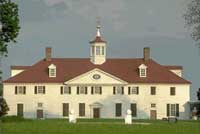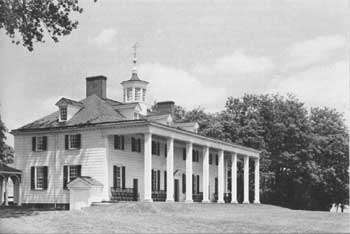







Survey of
Historic Sites and Buildings
 |
MOUNT VERNON Virginia |
 Mount Vernon |
| ||
Overlooking the Potomac River in a setting of serene elegance is George Washington's estate, Mount Vernon. Its sweeping lawns, beautiful gardens, magnificent mansion, and carefully planned outbuildings superbly represent a Virginia plantation home. Many shrines commemorate Washington as President, military leader, and statesman, but Mount Vernon best reveals the planter and country gentleman.
Mount Vernon was Washington's home for several years during his childhood and all his adult life—though he was absent for long periods while serving the Nation. At the estate, he entertained many U.S. and world dignitaries. He also hosted the Mount Vernon Conference (March 1785), after its initial sessions at nearby Alexandria. At this conference, whose goals he sympathized with but in which he took no direct part because he was not a delegate, representatives of Maryland and Virginia reached agreement on solutions to a variety of interstate problems. The success of this meeting led to the Annapolis Convention (September 1786), attended by representatives of five States. It was the immediate forerunner of the Constitutional Convention (May—September 1787).
The history of the estate dates back to the late 17th century. In 1674 John Washington, the great-grandfather of George, and Nicholas Spencer obtained a 5,000-acre grant along the Potomac, and 16 years later their heirs divided it. In 1726 Mildred Washington (Mrs. Roger Gregory), who had inherited the Washington half, which was then known as the Hunting Creek Plantation, sold it to her brother Augustine, George's father.
Augustine probably constructed the first portion of the present mansion over the foundations of a smaller, earlier dwelling that may have been erected by his father, Lawrence Washington, or his grandfather. From about 1735 until 1738, Augustine and his family, including young George, resided there after living at Wakefield, and in the latter year moved to the "Strother estate" (Ferry Farm), along the Rappahannock River opposite Fredericksburg. In 1740 Augustine deeded Mount Vernon to his eldest son, Lawrence, George's half-brother, who settled there at the time of his marriage 3 years later, and renamed the plantation Mount Vernon after Admiral Vernon, under whom he had served in the Caribbean. George spent part of his youth at the estate with Lawrence, who may have modified or rebuilt the house.
In 1754, or 2 years after Lawrence's death, George leased the property, then over 2,600 acres, from Lawrence's widow who had a lifetime right to it; upon her death, in 1761, George inherited it. In 1757-58, in preparation for his marriage the following year to Martha Custis, George thoroughly rebuilt the 1-1/2-story Georgian structure, which then contained four rooms bisected by a central hall on each floor. He enlarged the residence to 2-1/2 stories and remodeled it to a more impressive Palladian form. Because of his long absences on military duty in the French and Indian War until late in 1759, the bulk of the construction was supervised by William Fairfax, a neighbor.
 |
| Mount Vernon (Mount Vernon Ladies' Association.) |
For the next 15 years after his marriage in 1759, Washington lived as a prosperous planter, and made no further changes of consequence in his residence. In 1773 he decided to enlarge it, but he had hardly begun to do so when, in 1774-75, he went to Philadelphia to serve in the First and Second Continental Congresses. In the latter year, he was appointed as commander in chief of the Continental Army.
While Washington was away during the War for Independence, a distant kinsman, Lund Washington, carried out his plans for the estate. Lund enlarged the relatively modest main house from five to nine bays; constructed the piazza; added the detached, flanking wings, which connected to the central mansion by means of curving light arcades; built outbuildings; landscaped the grounds; and extended the gardens.
George found the mansion almost completed in 1781, when he stopped off on his way to and from Yorktown. After resigning his commission 2 years later, he returned to Mount Vernon; and in 1787 concluded the remodeling, when he placed the large octagonal cupola on the center of the roof.
That summer, Washington again traveled to Philadelphia, where he served as president of the Constitutional Convention. Two years later, elected as U.S. President, he departed once more and for the following 8 years was able to return only about twice a year. In 1797 he did so a final time, to retire; he died at Mount Vernon 2 years later. His wife lived there until she passed away in 1802. His nephew, Bushrod Washington, inherited the property, which remained in the family until 1858.
The mansion is an excellent example of Georgian architecture. Most striking is the high-columned, two-story piazza, which extends the full length of the structure and overlooks the Potomac. A triangular pediment tops the west elevation. Both the latter and the river facade have a central entrance and two side entrances. Two large interior chimneys mark the earlier ends of the dormered, hip-roofed mansion. A dentiled cornice adorns the roofline and the pediment. The exterior wood siding is beveled, and its paint contains sand to give the appearance of stone. Windows of both facades are shuttered.
On the first floor are the musicroom, west parlor, banquet hall, a bedchamber, dining room, and library. The second floor contains the blue bedroom, Lafayette's bedroom, the yellow bedroom, Nelly Custis' bedroom, and George Washington's bedroom. The third floor includes three bedrooms and two storerooms. The kitchen is outside but adjacent to the house.
A courtyard and bowling green, flanked by flower and kitchen gardens, extend from the west, or land, front of the house. To the north of the flower garden is a greenhouse. Various outbuildings, including smokehouse, workshops, and stables, have been restored in detail, as have the gardens and lawn. One modern building, built in 1928 in the same style as the other outbuildings, serves as a museum. The tombs of George and Martha Washington lie to the south of the mansion.
At its peak, during Washington's lifetime, the plantation contained more than 8,000 acres and was partitioned into five farms. After his death, four of them were divided and subdivided. By 1858 the estate had dwindled to 200 acres.
In 1858 the Mount Vernon Ladies' Association of the Union, concerned about the condition of the property, acquired title from Washington's great-grandnephew, John A. Washington, Jr. He had been unable, while operating the farm, to handle the numerous visitors or properly care for the house and grounds. By that time, none of the original furnishings remained. The association restored the buildings and grounds; eventually gained title to an additional 300 acres; and procured period pieces, many of them originals.
 |
 |
http://www.cr.nps.gov/history/online_books/constitution/site31.htm
Last Updated: 29-Jul-2004